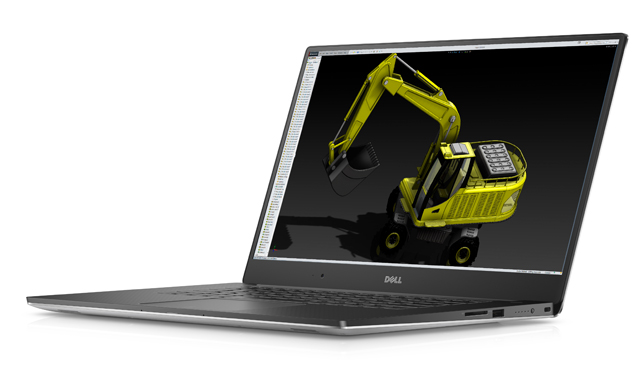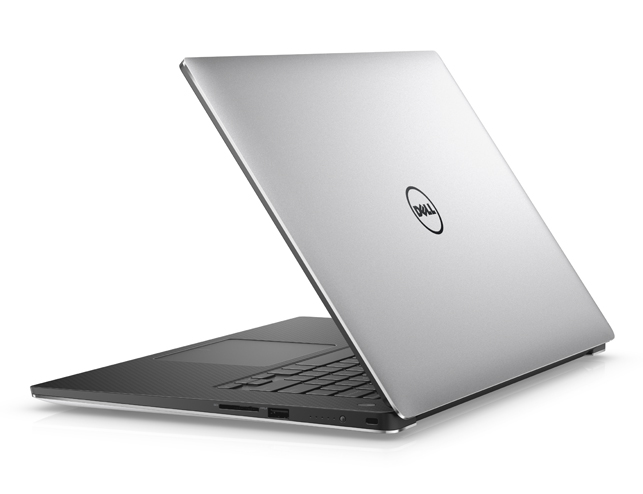
Precision 5510 – The quest for CAD-crunching performance and portability continues with Dell’s latest ultra-slim 15.6-inch mobile workstation
With mobile workstations, for years CAD users had to choose between performance and portability, but when the Dell Precision M3800 landed in 2013 everything changed.
With a fast quad core CPU and a GPU capable of handling medium sized 3D CAD assemblies it was suddenly possible to have your cake and eat it.
The Precision 5510 picks up where the M3800 left off and is Dell’s second generation ultra-portable 15.6-inch mobile workstation.
With an Intel ‘Skylake’ Xeon CPU, an Nvidia ‘Maxwell’ Quadro GPU, fast NVMe storage and double the memory of its predecessor there is plenty to get excited about. But Dell has also innovated in chassis design, delivering a significantly smaller machine with heightened good looks.
Considering the Precision 5510 is pitched as an ultra-portable mobile workstation, size is a good place to start. 15mm less wide and 19mm less deep than the Precision M3800, the Precision 5510 is significantly smaller than comparative ultra-portable 15.6-inch mobile workstations, including the HP ZBook Studio.
This is thanks to a new ‘Infinity display’, which features an extremely thin 6-7mm bezel. In addition to the obvious benefits of a smaller machine, the fact that the display almost reaches the edges makes for a beautiful design.
Build quality is superb. The CNC machined aluminium lid protects the vibrant UltraSharp PremierColor 4K touch display from knocks, while soft touch carbon fibre keeps the palm rest cool to touch.
There’s a reassuring solidity to this machine, on par with my 2015 model MacBook Pro. This may have something to do with its balanced form, which at 11.5mm at the front and 16.8mm at the rear is less tapered than the Precision M3800. Weight starts at 1.78kg, but our model was closer to 2kg. The 130W AC adapter comes in at 0.5kg with a UK plug.
The island style keyboard has a really great feel with excellent key travel, but there’s no numeric keypad for precise CAD input.
The large multi-touch touchpad takes some getting used to as it is more slippery than most. However, once the resistance was mastered, we soon became productive, zooming in and out of CAD models with two finger scrolling, or swiping between apps with three.
Our test machine’s Intel Xeon E3-1505M v5 CPU is perfect for CAD, delivering a more than respectable 2.80GHz (up to 3.70GHz) and four cores for multi-threaded operations, such as ray trace rendering.
16GB (2 x 8GB) of 2,133MHz DDR4 Memory is a good starting point for CAD, but the machine can also be factory installed with 32GB for more demanding users.
Interestingly, despite its Xeon CPU, the machine does not support Error Correcting Code (ECC) memory to protect against (admittedly rare) crashes, caused by background radiation. Unless you plan on using the machine for lengthy simulation or rendering runs, this shouldn’t put you off.
Scores in our processor-intensive 3ds Max rendering and Delcam PowerMill toolpath calculation benchmarks were almost identical to those of the HP ZBook Studio we reviewed in March.
Considering it has the exact same CPU this came as little surprise.
However, acoustics on the Precision 5510 were better or, more accurately, more predictable. Like the HP ZBook Studio, fan noise became annoying under heavy loads including CPU rendering, but the Precision 5510 was much quieter under less taxing operations and was sometimes almost silent. In contrast, the HP ZBook Studio was very trigger happy with its fans, kicking in even when performing some relatively moderate processing tasks.
3D performance was less predictable. On paper the standard Nvidia Quadro M1000M (2GB) GPU should satisfy the requirements of most mainstream CAD users, but because of the 4K UltraSharp PremierColor UHD IGZO touch panel it showed the strain with some of our more demanding test models.
At 4K (3,840 x 2,160) resolution, there are four times as many pixels to render than at FHD (1,920 x 1,080) and this can put an excessive load on what is essentially an entry-level CAD GPU.
The 18 frames per second (FPS) we achieved with the complex desktop PC SolidWorks assembly is adequate for precise navigation. However, this dropped down to low single figures with our more graphically intensive automotive assemblies.
The quality of the 4K panel cannot be disputed, and it is great for displaying detailed CAD models and renderings, but if it makes it hard to orient your model quickly and accurately it could be a big compromise.
If your workflows are relatively GPUintensive you may want to consider the optional FHD display. (for more info on the impact of 4K displays on 3D performance click here)
The Precision 5510 scores highly in storage as it can host both M.2 and 2.5-inch form factor drives. This means users can have the best of both worlds — the performance benefits of an M.2 NVMe Solid State Drive (SSD) and the low price per GB of a 2.5-inch SATA Hard Disk Drive (HDD).

There is a caveat though. When fitted with a 2.5-inch drive, as was our test machine, you are limited to a 3-cell 56-Wh battery. With M.2 only, there’s room for a 6-cell 81-Wh battery, meaning the machine will last longer on a single charge.
That’s not to say battery life with the 56-Wh cell is poor – our machine lasted 2h 20mins on the compute intensive PC Mark 8 battery test, which hammers both CPU and GPU. With office tasks and sporadic CAD use this would be much longer.
In terms of I/O ports the Precision 5510 is bang up to date. The USB 3.0 Type C port combines Thunderbolt 3, DisplayPort 1.2 and Ethernet (via a bundled adapter).
There are also two USB 3.0 ports with PowerShare, an SD card reader, HDMi and headphone and microphone combo jack. Bluetooth 4.0 and Dual-Band 2×2 802.11 ac Wireless LAN are standard.
The machine can be docked to an optional Dell Thunderbolt Dock (TB15) or Dell Dock (WD15) via USB 3.0. There’s much to like about the Dell Precision 5510 – decent performance for mid-range CAD, coupled with excellent portability and enviable good looks. It’s a small but significant improvement over the Precision M3800, not least because of its class-leading shrunk down frame.
The 4K display is a thing of beauty with a bezel so slim that it’s almost unnoticeable.
However, before getting seduced by the promise of ultra-crisp CAD geometry and beautiful renderings, it would be prudent to check if such a high-res panel impacts 3D performance with your datasets.
Unlike the mainstream 15-inch Dell Precision 7510 or 17-inch Dell Precision 7710, where you can compensate with a more powerful GPU, the Precision 5510’s one size fits all GPU means you don’t have that opportunity.
Precision 5510 – specifications
» Intel Xeon E3-1505M v5 CPU (2.80GHz up to 3.70GHz) (quad core)
» 16GB (2 x 8GB) DDR4 memory
» Nvidia Quadro M1000M (2GB) GPU
» 512GB 2.5-inch SATA Solid State Drive (SSD)
» 15.6” UltraSharp UHD IGZO (3 840 x 2,160) Touch Wide View LED-backlit
» 357mm (w) x 235.5mm (d) x 11.5mm (h)
» From 1.78kg
» Dell 56 WHr 3-Cell Lithium-Ion Battery
» Microsoft Windows 7 Professional 64-bit
» £1,987 (ex VAT)






